Introduction
Ferrets are curious, playful, and energetic pets that thrive with proper ferret enrichment to keep them mentally and physically stimulated. Without proper enrichment, they can become bored, destructive, or even depressed. The key to effective ferret enrichment is offering a variety of activities, toys, and interactive experiences that mimic their natural instincts.
In this guide, we’ll cover the best ways to enrich your ferret’s life, from exciting toys and engaging playtime ideas to outdoor adventures and DIY obstacle courses. Whether you’re a first-time ferret owner or looking for new ways to entertain your pet, this guide will ensure your ferret stays healthy, active, and full of joy.
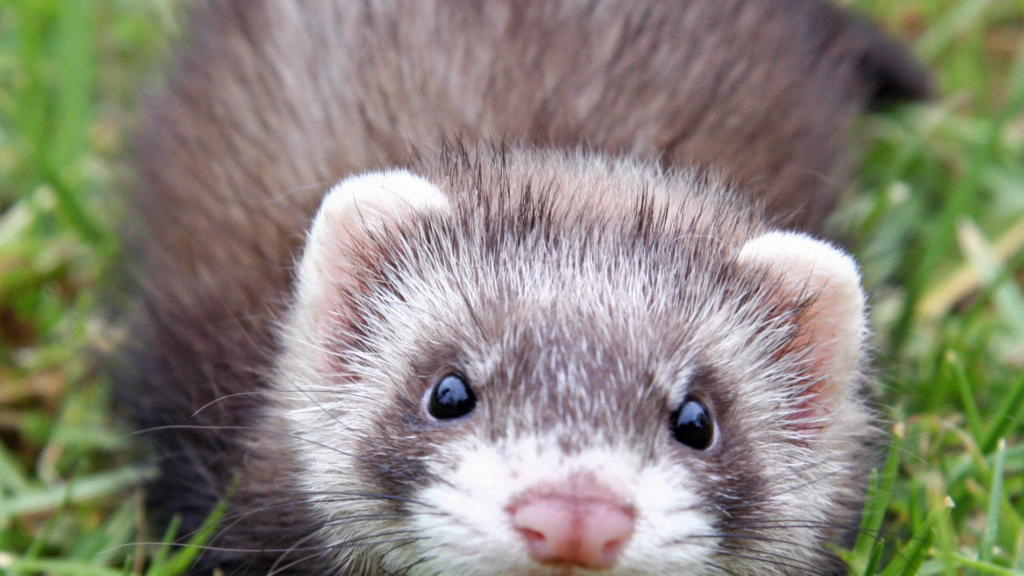
Why Ferret Enrichment is Essential for a Happy and Healthy Pet
Ferrets are naturally curious, intelligent, and highly active animals that need constant mental and physical stimulation to stay happy and healthy. Without proper enrichment, they can quickly become bored, frustrated, or even depressed, leading to unwanted behaviors. Unlike some pets that are content lounging around all day, ferrets thrive when they have exciting play opportunities, new challenges, and engaging environments. Providing ferret enrichment isn’t just about entertainment—it’s essential for their overall well-being, helping them stay fit, mentally sharp, and emotionally fulfilled.
The Risks of Boredom and Lack of Ferret Enrichment
A bored ferret is an unhappy ferret, and the signs of boredom are usually easy to spot. If your ferret is sleeping excessively, showing little interest in toys, or pacing around aimlessly, they may not be getting enough stimulation. Some ferrets may even become lethargic or withdrawn, avoiding social interaction.
Lack of enrichment often leads to destructive behaviors. Ferrets that don’t have enough to do may chew on furniture, dig up carpets, knock over household items, or stash objects in hard-to-reach places. In some cases, they may even become nippy or aggressive, taking out their frustration on their owners or other pets.
Enrichment improves both mental and physical health, keeping your ferret engaged, active, and emotionally balanced. Interactive play, puzzle toys, tunnels, and digging boxes all help prevent stress, obesity, and behavioral issues. By keeping their environment stimulating, you’re ensuring your ferret leads a longer, happier, and healthier life.
Lack of enrichment can lead to stress-related health issues. Learn more about keeping your ferret in top shape in our Ferret Health Guide.
Ferret Enrichment: How Ferrets Play in the Wild vs. at Home
In the wild, ferrets’ closest relatives—European polecats and black-footed ferrets—spend their days digging burrows, hunting prey, and exploring tunnels. These natural instincts don’t disappear just because a ferret is domesticated. Even pet ferrets crave activities that mimic their wild behaviors, and it’s important to provide them with safe ways to satisfy these instincts.
One of the best ways to replicate their natural environment at home is to create tunnels and hideouts. Ferret enrichment activities like tunnels, cardboard boxes, and hideouts can keep them engaged as they crawl through tubes and explore enclosed spaces.
Another great enrichment idea is digging boxes—ferrets love to burrow, so filling a bin with shredded paper, dried beans, or rice allows them to safely dig and tunnel just like they would in nature. Interactive feeding toys can also simulate hunting, making mealtime more stimulating. By understanding how ferrets play in the wild, you can create an exciting and enriching home environment that keeps them active, happy, and entertained.
Ensuring a happy and active life for your ferret starts with proper care. Check out The Ultimate Ferret Care Guide for everything you need to know about daily care.
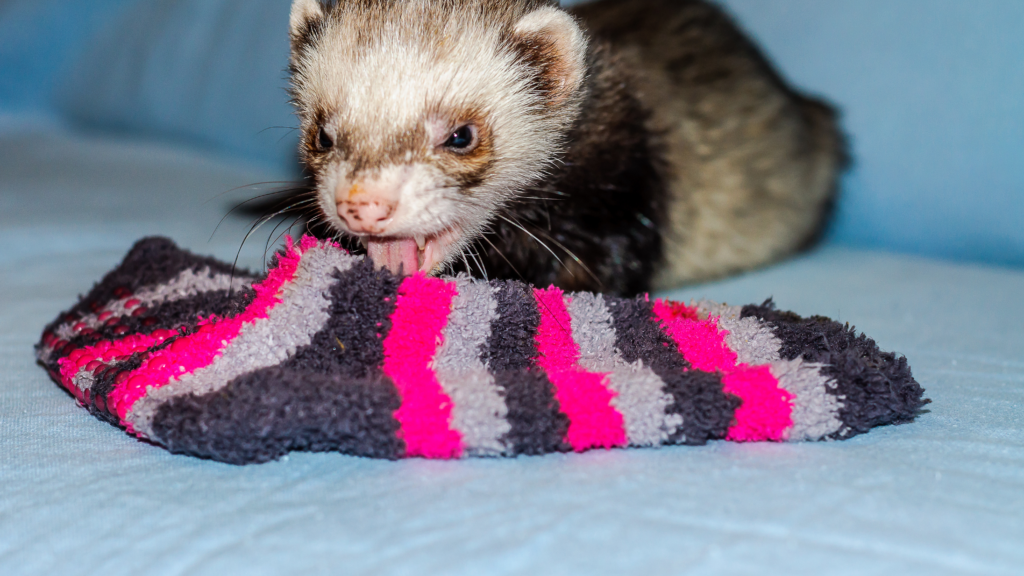
The Best Ferret Enrichment Toys for Endless Fun
Ferrets are natural explorers, and ferret enrichment plays a crucial role in satisfying their energy and curiosity. To keep them entertained and mentally stimulated, choosing the right toys is essential. The best ferret toys encourage movement, problem-solving, and instinctual behaviors like tunneling, hunting, and chewing. A variety of toys will help prevent boredom, reduce destructive behaviors, and keep your ferret happy and active. Whether it’s interactive puzzle toys, tunnel systems, or safe chew toys, here are some of the best options to add to your ferret’s playtime routine.
Interactive & Puzzle Toys
Ferrets are highly intelligent, which means they love toys that challenge their minds. Treat-dispensing toys are a fantastic way to engage your ferret’s natural curiosity and hunting instincts. These toys release a small treat when rolled or manipulated, encouraging your ferret to problem-solve and stay active while enjoying a reward. Look for ferret-safe treat balls or puzzle feeders that make them work for their food in a fun and interactive way.
Puzzle feeders are another great way to stimulate their brains. These toys require your ferret to slide, lift, or nudge compartments to find hidden treats. Not only do they keep your pet engaged, but they also slow down fast eaters and prevent overeating. Switching up puzzle toys and rotating different interactive games will keep your ferret excited and eager to play.
Tunnel Systems & Hideouts
If there’s one thing ferrets absolutely love, it’s tunnels! In the wild, ferrets’ closest relatives—European polecats—spend much of their time burrowing and exploring tight spaces. You can replicate this natural behavior by creating a fun tunnel setup for your ferret at home. Store-bought ferret tunnels, clear plastic tubing, or even flexible dryer vents make excellent tunnels that ferrets will race through for hours.
DIY hideouts are another great way to keep your ferret entertained on a budget. Cardboard boxes with cut-out holes, crinkly paper bags, and old fabric tunnels can all create exciting hiding spots. Some ferrets even enjoy pop-up tents, small cat caves, or hammocks with enclosed spaces where they can curl up for a nap after a long play session. The key is to provide varied tunnel shapes and hideouts so your ferret always has a new place to explore!
Chew Toys & Safe Alternatives
Chewing is an important part of ferret enrichment, and providing the right toys can prevent them from targeting furniture, shoes, or household items. Chewing is a natural behavior for ferrets, helping them relieve stress, teethe, and keep their jaw muscles strong. However, many common pet chew toys—like rubber dog toys or soft plastic items—are dangerous for ferrets since they can easily break apart and cause blockages.
To prevent destructive chewing, provide ferret-safe chew toys made from durable materials. Look for hard plastic or fabric chew toys designed for ferrets or small animals. Some ferrets also enjoy natural wooden chew sticks or pressed rawhide alternatives, but always monitor them to ensure they don’t swallow large pieces. Braided rope toys can also be a fun alternative, as long as they don’t fray into dangerous loose fibers.
By offering a mix of chew toys, tunnels, and interactive puzzle toys, you’ll create a fun, stimulating environment where your ferret stays entertained and engaged. Rotating toys regularly will keep playtime exciting and help prevent boredom-related mischief!
Some ferret breeds and body types are naturally more energetic. Learn more about different ferret types in our Ferret Breeds and Colors Guide.
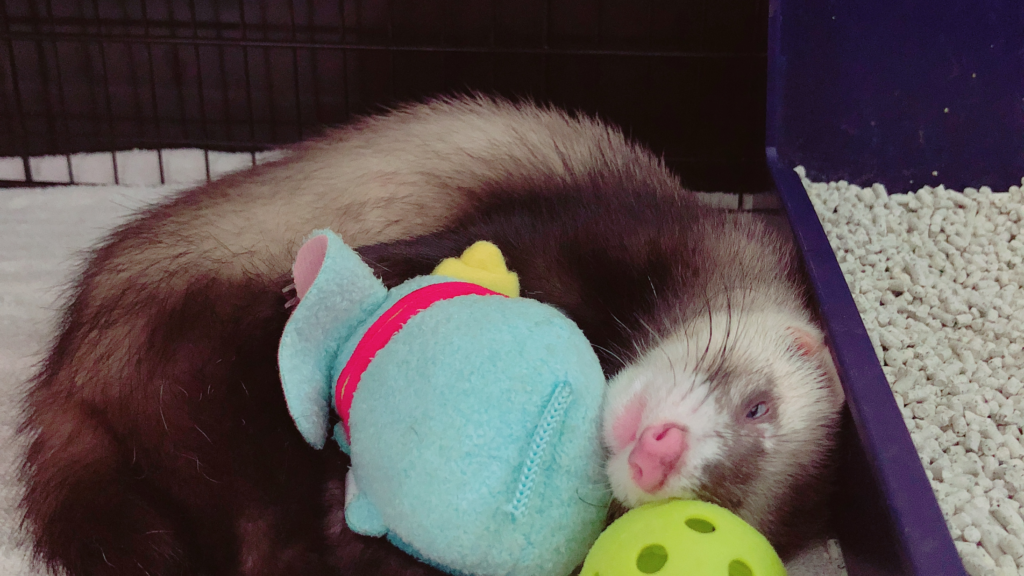
Ferret Enrichment Playtime Ideas to Keep Your Pet Engaged
Ferrets are high-energy, playful creatures that need daily enrichment to stay happy and healthy. Without regular playtime, they can become bored, destructive, or even depressed. The best way to keep your ferret entertained is to engage them in activities that mimic their natural behaviors, such as chasing, digging, and problem-solving. By introducing a mix of games, sensory activities, and training exercises, you can provide mental stimulation and physical exercise, ensuring your ferret stays active and engaged.
Chase & Hunting Games
Ferrets have strong hunting instincts, which is why they love chasing, pouncing, and stalking moving objects. One of the best ways to tap into this instinct is to use feather wands, small toy mice, or rolling balls to encourage playful hunting behavior. Try dragging a string with a soft toy attached across the floor and watch as your ferret eagerly chases and pounces on it.
For extra excitement, introduce remote-controlled toys or wind-up mice, which move unpredictably and keep your ferret engaged for longer. Always supervise these sessions to ensure your ferret doesn’t chew or swallow any small parts. Not only does this type of play provide great exercise, but it also satisfies their natural urge to hunt and capture prey in a safe way. By regularly incorporating chase games into their routine, you’ll help keep your ferret mentally sharp and physically active.
Digging & Burrowing Activities
Ferrets are natural diggers, and if they don’t have an appropriate outlet, they might turn to carpets, bedding, or furniture to satisfy their burrowing instincts. One of the best ferret enrichment ideas is creating a DIY dig box for a safe and fun digging experience. Fill a sturdy container or shallow bin with ferret-safe materials like shredded paper, dried beans, or uncooked rice. Your ferret will love diving in, tunneling through, and tossing the contents around!
For a budget-friendly option, repurpose an old cardboard box or plastic tub and fill it with soft rags, fleece strips, or crumpled paper. If you want to make it even more exciting, bury small toys or treats inside so your ferret can “hunt” for rewards while digging. Just be sure to avoid materials like sand, clay-based litter, or anything too small, as these can pose inhalation or ingestion hazards. Providing a safe and engaging digging area will not only keep your ferret entertained but also protect your home from unwanted destruction.
Hide-and-Seek & Obstacle Courses
Ferrets are naturally curious and love exploring new environments, making hide-and-seek and obstacle courses fantastic ways to keep them engaged. To create a fun obstacle course, use cardboard boxes, tunnels, and low ramps to design a mini adventure for your ferret. Place small rewards like treats or toys at different checkpoints to encourage them to navigate through the setup. This keeps them entertained while also providing great exercise.
Hide-and-seek is another interactive game that strengthens the bond between you and your ferret. Hide behind furniture or under a blanket and call their name—most ferrets will excitedly search for you! You can also hide their favorite toy or a treat under a pillow or inside a tunnel and encourage them to find it. This activity stimulates their problem-solving skills while keeping them active.
By incorporating hunting, digging, and exploratory activities into their daily routine, you’ll create a stimulating environment that keeps your ferret engaged and happy. Mixing up these playtime ideas ensures they never get bored and always have something exciting to look forward to!

Ferret Enrichment Through Social Interaction & Bonding Activities
Ferrets are incredibly social creatures that thrive on interaction and companionship. Unlike some pets that enjoy solitude, ferrets crave playtime, engagement, and affection from their owners and other animals. Without proper socialization, they can become lonely, bored, or even depressed. Whether you’re bonding one-on-one, introducing them to other household pets, or considering getting a second ferret, social interaction is essential for keeping them happy and well-adjusted. Here’s how you can strengthen your relationship with your ferret and create a fun, interactive environment.
One-on-One Playtime
Spending quality time with your ferret daily is one of the best ways to build trust and strengthen your bond. Ferrets are naturally playful and curious, so interactive play sessions help them associate you with fun and positive experiences. Engaging directly with your ferret—whether through tug-of-war with a soft toy, chase games with a feather wand, or simply rolling a ball back and forth—reinforces your connection and keeps them entertained.
When playing, always use safe, ferret-friendly toys that are free of small parts they could swallow. Avoid rough handling, as ferrets have delicate spines and small bones. If your ferret nips too hard during play, gently redirect their attention to a toy instead. Over time, consistent one-on-one interaction will make your ferret more affectionate and eager to spend time with you.
Can Ferrets Play with Other Pets?
If you have other pets, like cats or dogs, you may be wondering if they can safely interact with your ferret. The answer depends on your pets’ personalities and the introduction process. Some dogs and cats can coexist peacefully with ferrets, while others may see them as prey or react aggressively.
To introduce your ferret to another pet, start with controlled, supervised meetings in a neutral space. Keep your dog on a leash and your cat at a safe distance to observe their reactions. If they show curiosity without aggression, you can gradually allow closer interactions over time. Always watch for signs of stress or hostility, such as growling, hissing, or excessive chasing.
Never leave your ferret unsupervised with larger animals, even if they seem to get along. A simple play pounce from a dog or cat could accidentally injure a small ferret. Additionally, ferrets are known for stealing food and toys, which could trigger possessive behavior in some pets. With patience and careful supervision, many ferrets and household pets can develop a friendly and playful relationship.
Group Play – Should You Get More Than One Ferret?
Ferrets are highly social animals and often do best when they have a companion of their own kind. Having multiple ferrets allows them to engage in natural play behaviors, such as wrestling, chasing, and cuddling. They can keep each other entertained, reducing boredom and making them less dependent on human interaction for stimulation.
If you’re thinking about adding a second ferret to your home, the introduction process should be gradual and supervised. Start by allowing the ferrets to sniff each other through cage bars or in a neutral play area. Look for signs of curiosity rather than aggression—playful nipping, bouncing, and following each other are good signs! If one ferret becomes overly aggressive or defensive, separate them and try again later. Most ferrets will adjust within a few days to a few weeks.
Owning multiple ferrets can be rewarding, but it also means more food, bigger cages, and additional vet costs. If you have the time, space, and budget, getting a second ferret can greatly enhance their quality of life by providing a built-in playmate who understands their unique behaviors.
By engaging in one-on-one bonding, introducing them to other pets carefully, and considering a second ferret for companionship, you’ll create a socially enriched environment that keeps your ferret happy, active, and emotionally fulfilled!
Training an adopted ferret may take extra patience. Read our Ferret Adoption and Care Guide for helpful tips on socializing and bonding.
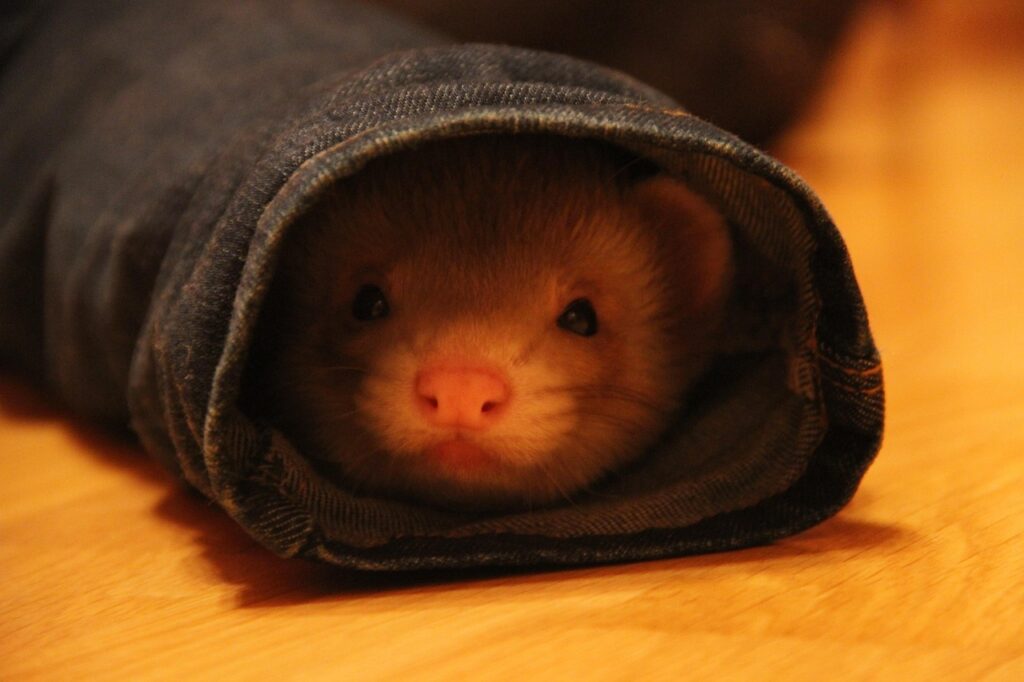
Safe Outdoor Ferret Enrichment: Exploring the World Beyond Their Cage
Ferrets are natural explorers, and supervised outdoor play can be a fantastic way to enrich their lives. The fresh air, new scents, and exciting surroundings provide sensory stimulation and physical exercise, helping to keep them happy and healthy. However, ferrets are also small, curious, and quick, which means outdoor time must be carefully planned and fully supervised to ensure their safety. Whether you’re training your ferret to walk on a harness and leash or setting up a secure outdoor play area, creating a controlled, risk-free environment is essential.
Harness Training & Walking Your Ferret
Taking your ferret on a leash walk might sound unusual, but with the right training, it can be an exciting and rewarding experience. The first step is choosing the right harness. Unlike dogs or cats, ferrets have long, flexible bodies, making it easy for them to slip out of poorly fitted harnesses. Look for a H-style harness designed specifically for ferrets, as these provide better security and comfort than basic strap models. Avoid harnesses that apply too much pressure on their neck or chest, as this can cause discomfort.
Once you have the right gear, start introducing the harness indoors. Let your ferret sniff and inspect it, then gradually put it on for short periods while offering treats and praise. When they seem comfortable, try walking them around your home before moving outdoors. For their first outdoor experience, choose a quiet, enclosed area with minimal distractions. Ferrets don’t walk in a straight line like dogs; instead, they prefer to explore at their own pace. Be patient, let them wander, and always stay close to prevent escapes or accidents. With consistency and positive reinforcement, leash training can become a fun and stimulating activity for both you and your ferret.
Outdoor Playpens & Safe Exploration Areas
If your ferret isn’t comfortable with a leash or you want to provide a safe outdoor experience without the need for constant supervision, setting up a secure outdoor playpen is a great alternative. Look for sturdy, escape-proof playpens made of metal or durable plastic panels with no wide gaps that your ferret can squeeze through. Make sure the playpen has a covered top to protect against predators like birds or stray animals.
When choosing an outdoor play area, avoid direct sunlight, as ferrets are prone to overheating. Instead, set up their playpen in a shaded area with a cool surface to prevent discomfort. Provide tunnels, digging boxes, and interactive toys to keep them engaged. Always double-check the play area for potential hazards like toxic plants, sharp objects, or gaps in fencing where your ferret might escape.
Never leave your ferret outdoors unattended, even in an enclosed space. Ferrets are expert diggers and climbers, meaning they can find creative ways to escape if not carefully monitored. With the right setup and supervision, outdoor play can become a safe, exciting, and enriching part of your ferret’s routine, helping them burn energy while exploring a whole new world of sights, smells, and textures!
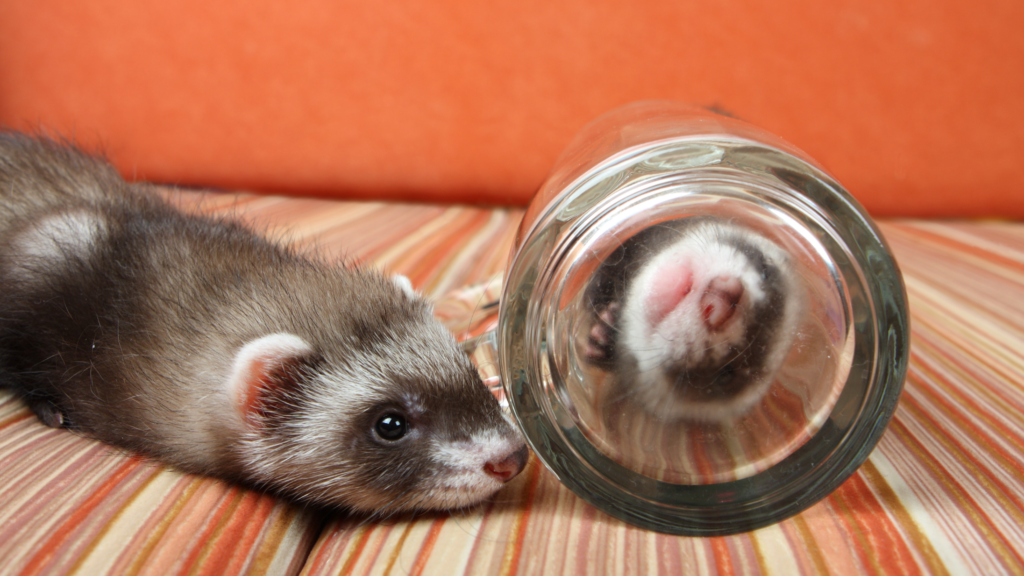
Creative DIY Ferret Enrichment Projects for Endless Fun
Ferrets are curious, playful, and always on the hunt for new adventures, so why not get creative with DIY enrichment projects? Store-bought toys are great, but you can make fun, budget-friendly enrichment activities right at home using everyday materials. Whether it’s building a ferret maze, a dig box, or repurposing household items, these DIY projects will keep your ferret entertained while stimulating their natural instincts. Plus, making these interactive toys yourself allows you to customize the experience based on your ferret’s unique personality and preferences!
How to Build a Ferret Maze or Obstacle Course
Creating a ferret maze or obstacle course is an excellent way to encourage exploration and problem-solving. Ferrets love navigating tunnels, climbing over objects, and squeezing through tight spaces, so setting up a maze is a fantastic enrichment activity. Here’s a simple step-by-step guide to building one:
- Gather materials: Use cardboard boxes, PVC pipes, soft fabric tunnels, or flexible dryer vents to create pathways and hideouts.
- Plan your maze: Arrange the boxes and tunnels in a way that encourages exploration, with multiple entry points, turns, and dead ends to make it more challenging.
- Add obstacles: Place small ramps, fabric-covered hurdles, or lightweight toys inside the maze for added engagement.
- Encourage exploration: Place a favorite toy or treat at the end of the maze to motivate your ferret to complete the challenge.
- Supervise playtime: Always watch your ferret while they navigate the maze to ensure they don’t get stuck or chew on unsafe materials.
You can change up the layout regularly to keep things exciting and even time your ferret to see how fast they can complete the course. This is a great way to combine exercise, mental stimulation, and fun!
DIY Dig Boxes & Sensory Bins
Ferrets are natural diggers, and a DIY dig box is the perfect way to satisfy this instinct without ruining your carpets or furniture. Best of all, you can make one for just a few dollars using materials you likely already have at home.
Here’s how to create a budget-friendly dig box:
- Choose a container: Use a plastic storage bin, a shallow cardboard box, or a large laundry basket as the base.
- Select a safe digging material: Fill the container with shredded paper, dry rice, uncooked beans, or cut-up fleece strips—all of which are safe for ferrets and easy to clean.
- Hide surprises inside: Bury small toys, crinkly balls, or treats in the dig box to encourage your ferret to root around and explore.
- Monitor playtime: Always keep an eye on your ferret to ensure they don’t ingest any of the digging materials.
For an added sensory experience, consider switching up the materials occasionally. Some ferrets love crinkly textures, while others enjoy soft fleece or paper-based materials. This DIY project provides hours of fun while giving ferrets a safe and engaging outlet for their natural burrowing instincts!
Repurposing Household Items for Ferret Fun
You don’t need to spend a fortune on fancy ferret toys—many everyday household items can be repurposed into exciting enrichment activities. Ferrets love to explore new textures, sounds, and shapes, so get creative with items you already have.
- Cardboard boxes – Cut holes in them to create mini hideouts, tunnels, or stacking towers for climbing fun.
- Paper bags – Ferrets love crinkly materials! Leave a few open paper bags around for them to burrow into.
- PVC pipes or dryer vents – These make excellent tunnels that mimic underground burrows.
- Old socks or fabric scraps – Fill them with rice or crinkly paper and sew them shut to make soft chew toys.
- Plastic bottles – Cut an opening in an empty bottle and fill it with small treats or noisy objects for a simple DIY rattle toy.
- Towel tunnels – Drape an old towel over furniture to create a cozy, dark tunnel for your ferret to explore.
By reusing items you already have, you can keep playtime exciting, engaging, and cost-effective. Just be sure to avoid anything with loose threads, toxic materials, or small pieces that could be swallowed.
DIY enrichment projects are a fantastic way to bond with your ferret while providing essential mental and physical stimulation. Whether you’re building a maze, setting up a dig box, or repurposing everyday items, these activities help keep your ferret’s mind sharp and body active. Plus, the best part? They’re fun for both you and your ferret!
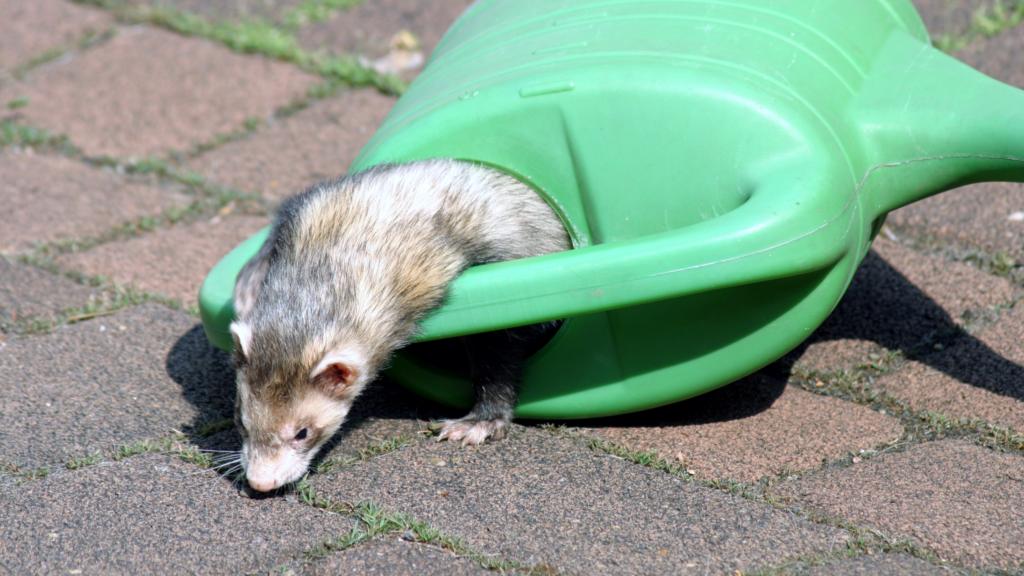
Ferret Enrichment: Rotating Toys & Keeping Things Exciting
Ferrets are naturally curious and intelligent, which means they quickly lose interest in toys that don’t provide enough novelty. While they may have a few favorite playthings, using the same set of toys every day can lead to boredom and destructive behavior. The key to keeping your ferret engaged is to rotate their toys regularly and introduce new environments or play areas that stimulate their instincts. Switching things up is key to effective ferret enrichment, keeping your pet entertained while preventing toy fatigue and ensuring they stay active and mentally stimulated.
How Often Should You Rotate Toys?
Just like humans, ferrets get bored of repetitive play. If your ferret starts ignoring their toys, pacing around their play area, or seeking out household objects instead, it’s a sign they need new stimulation. Rotating their toys every few days to a week can keep things exciting and prevent boredom from setting in.
A good schedule for toy rotation is to divide their toys into different sets and swap them out every 3-5 days. You don’t have to buy new toys constantly—just putting away a few items for a while and reintroducing them later can make them feel brand new to your ferret. Try alternating between interactive toys, tunnels, chew toys, and sensory play items to keep their interest piqued. By keeping their toy selection fresh and unpredictable, you encourage constant curiosity and playfulness, which contributes to their overall happiness and well-being.
Creating Themed Play Areas
Beyond rotating toys, another great way to keep your ferret engaged and excited is by setting up themed play areas. Changing their environment adds an extra layer of mental stimulation, as it encourages them to explore new textures, hiding spots, and challenges.
For example, try a “jungle adventure” setup by using cardboard boxes as caves, hanging fabric strips for vines, and placing tunnels for exploration. You can even scatter small plush toys or crinkly materials around to mimic a natural foraging experience. Another fun idea is a “burrow land” setup, where you arrange dig boxes, cozy hideouts, and soft bedding tunnels to encourage natural burrowing behavior.
To keep things fresh, rearrange their play space every couple of weeks by moving tunnels, swapping out climbing structures, or changing the placement of their favorite hideouts. Introducing unexpected twists to their environment is an excellent ferret enrichment strategy that keeps them engaged and eager to explore every day.
By combining toy rotation and creative play areas, you can provide a dynamic, ever-changing world for your ferret—one that satisfies their endless curiosity and ensures they’re always excited to play!
Conclusion – Keeping Your Ferret Happy & Entertained
Ferrets are high-energy, intelligent, and endlessly curious pets, which means keeping them entertained isn’t just a luxury—it’s a necessity. Without regular mental and physical stimulation, ferrets can become bored, frustrated, and even destructive. But with the right approach, you can turn every day into a fun-filled adventure for your furry friend.
Providing a mix of interactive toys, engaging playtime, and creative enrichment activities helps keep your ferret’s mind sharp and body active. Tunnels, dig boxes, puzzle feeders, and obstacle courses are fantastic ferret enrichment tools that mimic their natural behaviors, allowing them to burrow, chase, and explore. Even simple activities like rotating toys, rearranging their play space, or introducing new textures can make a world of difference. If you’re feeling adventurous, taking your ferret outside on a harness or setting up a safe playpen can open up a whole new world of exploration.
The key to a happy ferret is variety, creativity, and consistency. Keep experimenting with new games, challenges, and activities to keep things exciting. Most importantly, enjoy the bonding experience—ferrets thrive on interaction, and the time you spend playing together strengthens your relationship. With love, patience, and a solid ferret enrichment routine, your pet will live a joyful, active, and fulfilling life!




